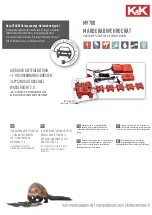
5b. For units with token relief such as Type CSB700ET,
see Figure 10 — Token Relief Assembly. Remove
token relief nut (key 46), spring retainer (key 42), relief
spring (key 41), nut (key 40) and relief valve spring
seat (key 43). Unscrew the stem (key 44) to separate
diaphragm assembly (key 55) and pusher post (key 50).
Check the diaphragm (key 55A) for damage and replace
if necessary.
Note
The diaphragm assembly (key 55) and the
upper spring case and lower casing must be
reassembled in a level, horizontal orientation
to ensure the relief stem is centered in the
upper spring case during use.
6 .
Reassemble the diaphragm assembly (key 55) unit in
the reverse order of the above steps. Assembly torques
for the diaphragm assembly are provided in Figure 10.
Before tightening the screw (key 45, for non-relief)
or stem (key 44, for token relief) into the pusher post
(key 50), place the loosely-assembled diaphragm
assembly (key 55) into position in the lower casing
(key 9, Figure 7 or 8), being sure that the pusher post is
hooked on the lever (key 10, Figure 7 or 8). Rotate the
diaphragm so that the diaphragm and lower casing holes
are aligned. Tighten the stem or screw using the proper
torque values (see Figure 10).
7 .
Reassemble the remaining parts by following steps 1 to 3
in reverse order. Tighten the hex nuts (key 16) and bolts
(key 15) in a crisscross pattern and tighten to the proper
torque value (see Figure 7 or 8).
valve Disk, Balanced port
assembly Diaphragm and Regulator
orifice Maintenance
Perform the following steps to disassemble, inspect and
replace the Valve Disk, Balanced Port Assembly Diaphragm
and Regulator Orifice:
1 .
Remove the cap screw (key 71, Figure 7 or 8) which
hold the lower spring casing (key 9) to the body
(key 70). Separate the lower spring casing from
the body.
2 .
Check the body O-ring (key 19 or key 21) for wear
replace if damaged.
3 .
Remove the balanced port assembly (key 36, Figure 7
or 8) from the body (key 70).
4 .
Examine the valve disk (key 36J, Figure 9) for nicks or
other damage. If damage is present, replace both the
disk and the balanced port diaphragm (key 36E) and
associated diaphragm O-ring (key 36N), that comes
into direct contact with the inner flange of the balanced
port diaphragm. Start the process of replacing the disk
by disassembling the balanced port assembly (key 36).
Remove the four cap screws (key 36R) and then the
retainer plate (key 36S).
5 .
Grasp the spring retainer (key 36B) and slide the housing
(key 36F) away to expose the diaphragm (key 36E)
and disk (key 36J). Still grasping the spring retainer,
insert a 5 mm / 0.20 in. Allen wrench into the disk screw
(key 36D) and unscrew.
6 .
Remove the disk (key 36J), discard and replace if
damaged. Slide the diaphragm O-ring (key 36N)
off the stem (key 36A) along with the diaphragm
(key 36E). Slide the new diaphragm over the stem in
the same manner that it was removed, make sure that
it completely contacts the surface of the diaphragm
retainer (key 36H).
7 .
Reassemble the balanced port assembly in reverse
order of the above. Ensure Dow Corning
®
33 or
comparable extreme low temperature lubricant
completely coats the O-rings (keys 36N and 36P),
stem (key 36A) and the center bore of the brass cap
(key 36G). Assemble with proper torques provided in
Figure 9.
8 .
Examine the seating edge of the orifice (key 25,
Figure 7 or 8). If it is nicked or rough, replace the orifice
and O-ring (key 82). The orifice installation torque range
is provided in Figure 7 or 8. If a slam-shut is installed
on the backside of the body, reference the Type VSX8’s
Instruction Manual for inspection and removal of the
overpressure protection orifice (key 26, see Figure 13)
and O-ring (key 27).
9 .
Reassemble the regulator in reverse order of the
above steps. Tighten the bolts (key 71) using the proper
torque values (see Figure 7 or 8).
Regulator Reassembly
As indicated by the square callouts in Figures 7 to 13, it
is recommended that a good quality low temperature pipe
thread sealant be applied to pressure connections and
fittings and a good quality low temperature lubricant be
applied to O-rings. Also apply an anti-seize compound to the
adjusting screw threads and other noted areas as needed.
Tighten bolts, screws and stem using proper torque (see
Figures 7 to 12).
parts ordering
The type number, orifice size, spring range and date of
manufacture are stamped on the nameplate. Always provide
this information in any correspondence with your local Sales
Office regarding replacement parts or technical assistance.
When ordering replacement parts, reference the key
number of each needed part as found in the following parts
list. Separate kit containing all recommended spare parts
is available.
Dow Corning
®
is a registered trademark owned by Dow Corning Corporation.
CSB700 Series
15










































